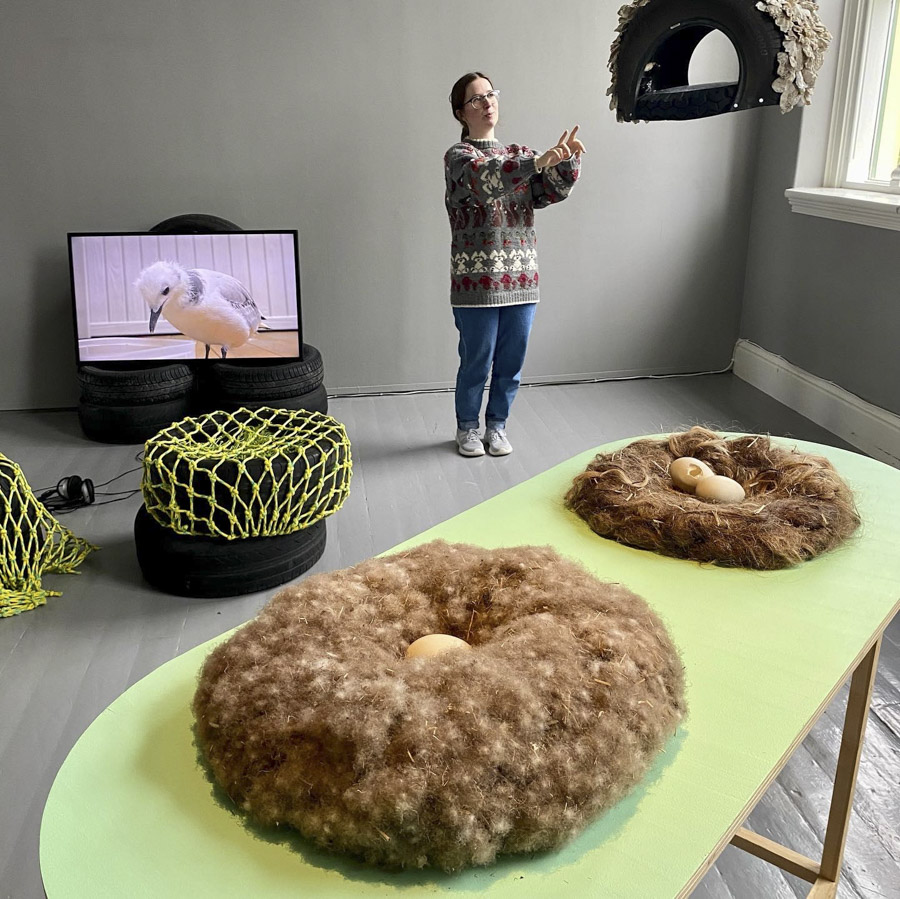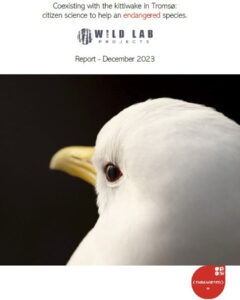December 19, 2023
Our annual report is out, and this first year is a big success!

In May 2023, the Hurtigruten Foundation awarded Wild Lab Projects a grant to support a citizen science project aiming at engaging the public , in monitoring kittiwakes in Tromsø, promoting coexistence, and raising awareness and empathy for this endangered species.
Our annual report (link at the end of this article) describes how we used the grant, what our citizen scientists have achieved and how we’ll keep supporting the black-legged kittiwake in Tromsø in collaboration with our research partner the Norwegian institute for nature research/NINA.
The grant from the Hurtigruten Foundation played a crucial role in kickstarting this innovative project.
“By showing tolerance and understanding, we can limit the loss of natural diversity along our coast” (Tone Reiertsen, NINA)

Participation
Between June 29 and September 29, 111 participants contributed to the 21 citizen science kittiwake walks in Tromsø city center. The participants were local volunteers, visitors and tourists. The average duration of these walks was over 2 hours.

Number of nests
With the help of the participants, we found 321 used nests in Tromsø city center. Over 50 additional used nests were observed on the three tripod-shaped “kittiwake hotels”. According to our research partner the Norwegian institutt for nature research, the number of kittiwakes in Tromsø city center has increased compared to the previous year. This local trend contrasts with the continuous decrease of the kittiwake population in Western and Northern Europe.

Deterrents
We paid attention to the deterrents and looked at their effectiveness. A quarter of all the nests found in Tromsø city center (excluding the nests on the kittiwake hotels) were built on some type of deterrent. This observation left the participants with the impression that the current methods to ward off kittiwakes are somehow ineffective.

Spikes left a negative impression on the participants who saw kittiwakes covered in blood as a result of injuries and punctures. Although correlation in not causation, dead chicks were often observed on nests built on spikes.

Citizen scientists: stewards and sentinels
The participants learned about the different species of seagulls living in Tromsø. This was one of the goals of the citizen science walk since kittiwakes pay the price of the bad reputation of the common gull and the herring gull. Teaching the differences between the species proved an effective way to fight prejudices against kittiwakes.
We put several chicks back into their nest after they accidentally fell off. Thanks to the regular visits, we could keep track of the breeding status of each nest, and put the chicks back into the correct nest.

The citizen science walks were also useful to detect birds in distress and respond immediately, for example if a kittiwake was seen trapped in a net.
When the bird flu outbreak hit Tromsø, the participants became sentinels, and we could report to the authorities and to our research partner when we found dead birds, and also keep track of the mortality in the city center.
These citizen science kittiwake walks had an effect beyond the group of participants, as people in the streets were intrigued and often stopped to ask what we were doing, and what we were looking at with binoculars. These interactions, often with locals, were opportunities to raise awareness and debate about coexistence, and exposed the participants to various reactions and opinions.
The project on Vimeo
Aztrid Novillo, an inspiring and talented young female nature filmmaker made an educational video of the project. Since then, Aztrid received mentorship from the nonprofit organization Girls Who Click, which empowers girls to enter the male-dominated field of nature photography and use their work to further conservation efforts around the world. Wild Lab Projects wishes Aztrid the best of luck in her projects!

Collaboration with the Center for Contemporary Art (Kunstforening)
We partnered with the Center for Contemporary Art, which hosted an exhibition called “I… Seagulls! An exhibition about living together”.
After the two-hour citizen science walk, the participants were welcomed by one of the artists contributing to the exhibition, Irene M. Kaltenborn, the curator Kaare Grundvaag, or the general manager Camilla Fagerli depending on the day. After experiencing the scientific and social dimensions of the walk, participants concluded the walk with an artistic immersion. This guided tour of the art exhibition enriched the participants’ experience considerably and reinforced the take-away message concerning the importance of living together.

What we’ll do next
– We will resume the citizen science kittiwake walks in 2024, and engage the public to raise awareness and empathy for the kittiwake.
– We will reinforce our collaborations with our research partner the Norwegian institute for nature research, and with other parties engaged in protecting the Norwegian kittiwakes in Tromsø.
– We will maintain existing collaborations with tour operators and initiate new ones to make tourism more regenerative in Tromsø.
– We will engage the youth and collaborate with local schools and teachers who can use this citizen science project in their curriculum.
– We will persist in considering the presence of kittiwakes as an additional asset to the city of Tromsø and an integral part of Tromsø’s identity.

Read the full report :




